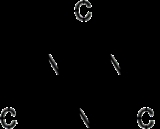
Cyanuric chloride
Encyclopedia
Cyanuric chloride is the inorganic compound
with the formula
(NCCl)3. This colorless solid is the chlorinated derivative of 1,3,5-triazine
. It is the trimer
of cyanogen chloride
. Cyanuric chloride is the main precursor to the popular but controversial herbicide atrazine
.
, which is trimerized at elevated temperatures over a carbon catalyst:
In 2005, approximately 200,000 tonnes were produced.
. Such reactions rely on the easy displacement of the chloride with nucleophile
s such as amines:3 + 2 RNH2 → (RNHCN)(ClCN)2 + RNH3+Cl-
Other triazine herbicides, such as simazine
, anilazine
and cyromazine
are made in an analogous way.
Cyanuric chloride is also used as a precursor to dyes and crosslinking agents. The largest class of these dyes are the sulfonated triazine-stilbene optical brighteners (OBA) or fluorescent whitening agents (FWA) commonly found in detergent formulas and white paper. Many reactive dyes also incorporate a triazine ring. They are also manufactured by way of the chloride displacement reaction shown above.
in organic synthesis
for the conversion of alcohols and carboxylic acids into alkyl and acyl chlorides, respectively:
It is also used as a dehydrating agent and for the activation of carboxylic acids for reduction to alcohols. Heating with DMF
gives "Gold's reagent" Me2NCH=NCH=NMe2+Cl-, which is a versatile source of aminoalkylations and a precursor to heterocycles.
The chloride centers are easily replaced by amine
s to give melamine
derivatives, for example in the synthesis of dendrimer
s:
It is also employed the synthesis of an experimental adenosine receptor
ligand.:
Cyanuric Chloride can also be used as an alternative to oxalyl chloride
in the Swern oxidation
.
Inorganic compound
Inorganic compounds have traditionally been considered to be of inanimate, non-biological origin. In contrast, organic compounds have an explicit biological origin. However, over the past century, the classification of inorganic vs organic compounds has become less important to scientists,...
with the formula
Chemical formula
A chemical formula or molecular formula is a way of expressing information about the atoms that constitute a particular chemical compound....
(NCCl)3. This colorless solid is the chlorinated derivative of 1,3,5-triazine
1,3,5-Triazine
1,3,5-triazine, also called s-triazine, is an organic chemical compound with the formula 3. It is a six-membered heterocyclic aromatic ring, one of several isomeric triazines. S-triazine and its derivatives are useful in a variety of applications.-Use in organic chemistry:As a reagent in organic...
. It is the trimer
Trimer (chemistry)
In chemistry, a trimer is a product derived from three identical precursors. Trimers are typically cyclic. Chemical compounds that often trimerise are aliphatic isocyanates and cyanic acids. Often, trimerization competes with polymerization....
of cyanogen chloride
Cyanogen chloride
Cyanogen chloride is an inorganic compound with the formula NCCl. This linear, triatomic pseudohalogen is an easily condensed colorless gas. More commonly encountered in the laboratory is the related compound cyanogen bromide, a room-temperature solid that is widely used in biochemical analysis and...
. Cyanuric chloride is the main precursor to the popular but controversial herbicide atrazine
Atrazine
Atrazine, 2-chloro-4--6--s-triazine, an organic compound consisting of an s-triazine-ring is a widely used herbicide. Its use is controversial due to widespread contamination in drinking water and its associations with birth defects and menstrual problems when consumed by humans at concentrations...
.
Production
Cyanuric chloride is prepared in two steps from hydrogen cyanide via the intermediacy of cyanogen chlorideCyanogen chloride
Cyanogen chloride is an inorganic compound with the formula NCCl. This linear, triatomic pseudohalogen is an easily condensed colorless gas. More commonly encountered in the laboratory is the related compound cyanogen bromide, a room-temperature solid that is widely used in biochemical analysis and...
, which is trimerized at elevated temperatures over a carbon catalyst:
- HCN + Cl2 → ClCN + HCl
- 3 ClCN → (ClCN)3
In 2005, approximately 200,000 tonnes were produced.
Industrial Uses
It is estimated that 70% of cyanuric chloride is used in the preparation of the triazine-class pesticides, especially atrazineAtrazine
Atrazine, 2-chloro-4--6--s-triazine, an organic compound consisting of an s-triazine-ring is a widely used herbicide. Its use is controversial due to widespread contamination in drinking water and its associations with birth defects and menstrual problems when consumed by humans at concentrations...
. Such reactions rely on the easy displacement of the chloride with nucleophile
Nucleophile
A nucleophile is a species that donates an electron-pair to an electrophile to form a chemical bond in a reaction. All molecules or ions with a free pair of electrons can act as nucleophiles. Because nucleophiles donate electrons, they are by definition Lewis bases.Nucleophilic describes the...
s such as amines:3 + 2 RNH2 → (RNHCN)(ClCN)2 + RNH3+Cl-
Other triazine herbicides, such as simazine
Simazine
Simazine is a herbicide of the triazine class. The compound is used to control broad-leaved weeds and annual grasses.-Physical properties:* Water solubility: 5 mg/L at 20 °C...
, anilazine
Anilazine
Anilazine is an organic compound with the chemical formula C9H5Cl3N4. It is a pesticide used on crops. It comes under the category of triazine fungicides. It is used for controlling fungus diseases which attack lawns and turf, cereals, coffee, and a wide variety of vegetables and other crops...
and cyromazine
Cyromazine
Cyromazine is a triazine insect growth regulator used as an insecticide and an acaricide. It is a cyclopropyl derivative of melamine. Cyromazine works by affecting the nervous system of the immature larval stages of certain insects....
are made in an analogous way.
Cyanuric chloride is also used as a precursor to dyes and crosslinking agents. The largest class of these dyes are the sulfonated triazine-stilbene optical brighteners (OBA) or fluorescent whitening agents (FWA) commonly found in detergent formulas and white paper. Many reactive dyes also incorporate a triazine ring. They are also manufactured by way of the chloride displacement reaction shown above.
Organic synthesis
In one specialized application, cyanuric chloride is employed as a reagentReagent
A reagent is a "substance or compound that is added to a system in order to bring about a chemical reaction, or added to see if a reaction occurs." Although the terms reactant and reagent are often used interchangeably, a reactant is less specifically a "substance that is consumed in the course of...
in organic synthesis
Organic synthesis
Organic synthesis is a special branch of chemical synthesis and is concerned with the construction of organic compounds via organic reactions. Organic molecules can often contain a higher level of complexity compared to purely inorganic compounds, so the synthesis of organic compounds has...
for the conversion of alcohols and carboxylic acids into alkyl and acyl chlorides, respectively:
It is also used as a dehydrating agent and for the activation of carboxylic acids for reduction to alcohols. Heating with DMF
Dimethylformamide
Dimethylformamide is an organic compound with the formula 2NCH. Commonly abbreviated as DMF , this colourless liquid is miscible with water and the majority of organic liquids. DMF is a common solvent for chemical reactions...
gives "Gold's reagent" Me2NCH=NCH=NMe2+Cl-, which is a versatile source of aminoalkylations and a precursor to heterocycles.
The chloride centers are easily replaced by amine
Amine
Amines are organic compounds and functional groups that contain a basic nitrogen atom with a lone pair. Amines are derivatives of ammonia, wherein one or more hydrogen atoms have been replaced by a substituent such as an alkyl or aryl group. Important amines include amino acids, biogenic amines,...
s to give melamine
Melamine
Melamine is an organic base and a trimer of cyanamide, with a 1,3,5-triazine skeleton. Like cyanamide, it contains 66% nitrogen by mass and, if mixed with resins, has fire retardant properties due to its release of nitrogen gas when burned or charred, and has several other industrial uses....
derivatives, for example in the synthesis of dendrimer
Dendrimer
Dendrimers are repetitively branched molecules. The name comes from the Greek word "δένδρον" , which translates to "tree". Synonymous terms for dendrimer include arborols and cascade molecules. However, dendrimer is currently the internationally accepted term. A dendrimer is typically symmetric...
s:
It is also employed the synthesis of an experimental adenosine receptor
Adenosine receptor
The adenosine receptors are a class of purinergic receptors, G protein-coupled receptors with adenosine as endogenous ligand.-Pharmacology:...
ligand.:
Cyanuric Chloride can also be used as an alternative to oxalyl chloride
Oxalyl chloride
Oxalyl chloride or ethanedioyl dichloride is a chemical compound with the formula 2. This colourless, sharp-smelling liquid, the diacid chloride of oxalic acid, is a useful reagent in organic synthesis...
in the Swern oxidation
Swern oxidation
The Swern oxidation, named after Daniel Swern, is a chemical reaction whereby a primary or secondary alcohol is oxidized to an aldehyde or ketone using oxalyl chloride, dimethyl sulfoxide and an organic base, such as triethylamine...
.




